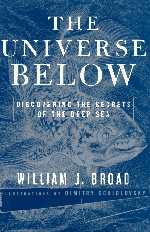
| The Universe Below: Discovering the Secrets of the Deep Sea | |||||||||||||||
| William J. Broad, Dimitry Schidlovsky (Illustrator) | |||||||||||||||
| Simon & Schuster, 415 pages | |||||||||||||||
|
A review by Stephen M. Davis
While my experience with books on ocean exploration has generally consisted of
works containing grainy photographs of underwater steps descending to the Temple of
Poseidon in Atlantis, I was entertained by William Broad's book and recommend it.
There were spots where the writing became a bit academic. But there are always
points of interest, even in a section like "Battle Zone," where much of the discussion centers
around the evolution of the submersible from a civilian oddity to a military vehicle of
espionage, then back to a civilian treasure hunter. By way of example, I quote a passage in
which Mr. Broad describes a near-catastrophe for the submersible Trieste:
The author is most comfortable when he is a personal witness to events, and not just
history's commentator. In the section entitled "Canyon", Mr. Broad gets to travel with the
Monterey Bay Aquarium Research Institute (MBARI) as they head out to sea with the robot
submersible Ventana on one of their routine probings of the Monterey Canyon.
Monterey Canyon is a submarine fissure that begins in Monterey Bay, California, and
deepens quickly to a depth of more than two miles. As MBARI's president, Peter G. Brewer,
says, "This is the only place in the country where you can leave the dock and, before you've
finished your cup of coffee, you're at true oceanic depths."
Mr. Broad manages in "Canyon" to describe in some detail the progress Ventana
makes as it descends more than a kilometer into Monterey Canyon, video-taping its
surroundings and sucking in specimens at the request of scientists on board a ship floating
high above the submersible.
After sucking a squid into one of Ventana's specimen containers, the scientists are
overjoyed :
In this book, the reader will find passages about global warming, radioactive
contamination of the ocean, and new methods of hunting for treasure on wrecks that were
previously inaccessible. The reader, though, will also learn about new deep-sea species that
are being found almost daily, underwater "smokestacks" that contain unbelievable mineral
riches, and espionage games that are as audacious as any spy operation run on solid ground.
I think the reader will find The Universe Below to be good non-fiction entertainment.
Steve is faculty member in the English department at Piedmont Technical College in Greenwood, S.C. He holds a master's in English Literature from Clemson University. He was voted by his high school class as Most Likely to Become a Young Curmudgeon. | ||||||||||||||
|
|
If you find any errors, typos or other stuff worth mentioning,
please send it to editor@sfsite.com.
Copyright © 1996-2014 SF Site All Rights Reserved Worldwide
